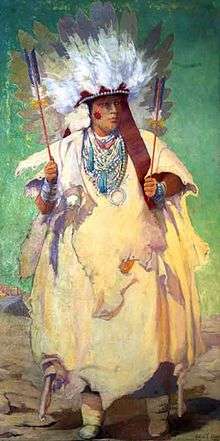Smoki Museum
The Smoki Museum of American Indian Art and Culture, located in Prescott, Yavapai County, Arizona holds collections of Native American artifacts. Effective Feb. 10, 2020, the museum is now named the Museum of Indigenous People (MIP).[1]

| |
| Location | 147 N. Arizona Avenue, Prescott, Arizona |
|---|---|
| Coordinates | 34.5435°N 112.4590°W |
| Type | Native American |
| Visitors | 7,000 per year |
| Director | Cindy Gresser |
| Website | www |

History
The museum was started, in part, due to the efforts of Kate Cory, who donated eight of her paintings and her photograph album for its collection, and Dr. Byron Cummings of the University of Arizona in order to house some of the artifacts he and his crews were excavating at the time. Sharlot Hall provided other ethnographic information. The museum evolved from events conducted by a group of white Arizona residents who enacted Native American ceremonial dances, which was not appreciated by the Hopi people. The white ceremonial enactors called themselves the "Smoki Tribe."[2]
Beginning in 1931, Smokis met and held ceremonial presentations at a pueblo next to the current museum location.[3] The stone and log museum building was constructed in 1935[4] by the Civilian Works Administration and operated as a museum.[3] By 1990, the "Smoki Tribe" no longer performed dances due in part to pressure by Hopis to desist what were considered insulting portrayals of their sacred ceremonial practices.[5] Instead of "Smoki Tribe" performances, the museum hosts educational programs.[6] In 1991 the museum became a non-profit museum. It is now listed on the National Register of Historic Places[3]
Overview
Its more than 2000 artifacts include pottery, basketry, lithics and beadwork. The articles range in age dating from the Pre-Columbian era up to modern times. The baskets in the museum collection are considered among the best in the United States, and the pottery displays are impressive. Other exhibits rotate on an irregular schedule, but average 4-6 months in duration.[4][7]
See also
References
- Flagstaff Business News, Sunday, April 1, 2020. .
- Susan Bernardin. Trading Gazes: Euro-American Women Photographers and Native North Americans, 1880-1940. Rutgers University Press; 2003. ISBN 978-0-8135-3170-0. p. 19–20, 76.
- Raymond E. Miller. Prescott. Arcadia Publishing; 2010. ISBN 978-0-7385-7906-1. p. 98.
- Marty Campbell. Arizona Family Field Trips. AZ Adventures; 1 January 2002. ISBN 978-0-9722286-0-2. p. 53.
- Tim Hull. Moon Arizona. Avalon Travel; 10 May 2011. ISBN 1-59880-929-6. p. 316.
- Robert D. Leighninger. Long-range Public Investment: The Forgotten Legacy of the New Deal. Univ of South Carolina Press; 1 January 2007. ISBN 978-1-57003-663-7. p. 52.
- DK Publishing. DK Eyewitness Travel Guide: Arizona & the Grand Canyon. DK Publishing; 1 October 2012. ISBN 978-0-7566-9554-5. p. 71.
Further reading
- Ginger Johnson. Native American Baskets of the Smoki Museum. Ginger Johnson; 1997.
- Leonard Peltier; Adam Mikos; Smoki Museum. Warrior Elder: Paintings. Smoki Museum American Indian Art and Culture; 2007.
- Smoki Museum; Arizona Archaeological Society. Yavapai Chapter. The Smoki Museum and the Yavapai Chapter of the Arizona Archaeological Society Present the Puzzle of Ancient Prescott: Pieces from Coyote Ruin. Smoki Museum; 2005.
- Smoki People, Inc; Prescott Chamber of Commerce, Arizona. Smoki Museum: Artifacts of the Ancient Southwestern Indian Preserved by the Smoki People, Prescott, Arizona. Smoki People; 197?.